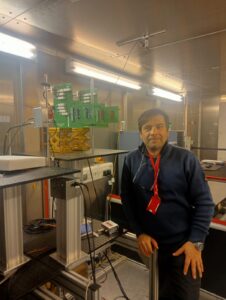Dr. Francesco Pintacuda is using the ISIS@MACH ITALIA suite of instrumentation alongside ChipIR to build a more accurate picture of the effects of high energy astroparticle impacts on electronic components.
By: Shibl Gill – 6 July 2024
During a 2003 election in Belgium, polling officials noted an unusual result: a candidate had received more votes than was possible in that jurisdiction. A clue as to what had gone on lay in the precise number of extra votes that the electronic polling machine had counted – 4096. Given that 4096 = 212 suspicions turned to the computing systems involved, and eventually, investigations ultimately determined that the most likely explanation was a single-event bit flip caused by cosmic rays.

I recently got the chance to sit down with Dr. Francesco Pintacuda, a designer and researcher with the electronics firm, STMicroelectronics. He specialises in analysing the effects of ubiquitous radiation in space and the atmosphere on power electronics transistors. In the over six years he has spent looking at failure mechanisms in electronic components due to cosmic ray interactions, Dr. Pintacuda has been working with automotive companies, space agencies and the aviation industry to help understand the effects of particle collisions on electronic components and creating more robust electronic components.
In order for Dr. Pintacuda to carry out his work, he needs frequent access to not only chip irradiation facilities such as ChipIR at the ISIS Neutron and Muon source, but also smaller and medium range instrumentation such as scanning electron microscopes and X-ray diffractometers. This is where he encountered the ISIS@MACH ITALIA infrastructure and the opportunities for industrial users to apply for time on a range of over sixty different instruments for the analysis of materials.
Due to the sheer range of instrumentation and techniques involved in the analysis of failure mechanisms in electronics, Dr. Pintacuda pointed out that it was imperative for him to work alongside dedicated specialist instrument scientists. He explained:
“I had been working with ChipIR for a while and it was clear we needed to expand our methodology and so I went to the ISIS@MACH ITALIA group – I went to Triestino Minniti and Giovanni Romanello and I explained my instrument and expertise needs. They involved other people at different units to help us home in on the details of our experimental methodology.”
As an industrial user of some of these instruments and techniques, Dr. Pintacuda was especially interested in learning about the latest instruments and techniques being developed in this burgeoning industry, and that’s where ISIS@MACH ITALIA was perfectly suited to his needs. Working with industrial users is a key part of the IM@IT mission as it allows the instrument scientists to also expand their skills and apply them to novel problems and applications.
Having already completed four or five experiments with IM@IT, Dr. Pintacuda expressed his satisfaction with his overall experiment experience:
“it was very easy and transparent and after my experiment with for example tomography, there is a lot of data that has to be analysed to extract the results and I was very pleased with the support I got on that aspect as well”.
